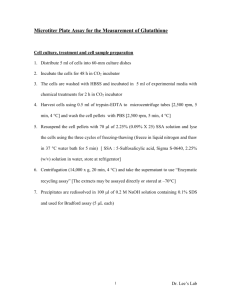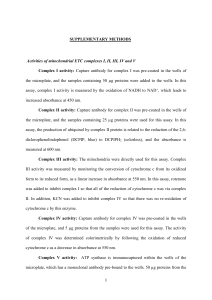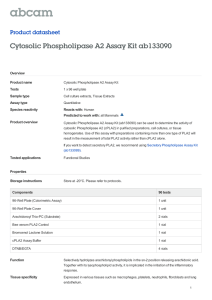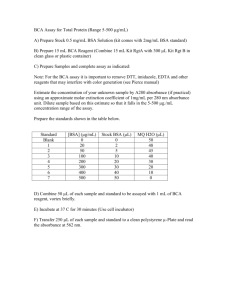ab133089 – Secretory Phospholipase A2 Assay Kit Instructions for Use
advertisement
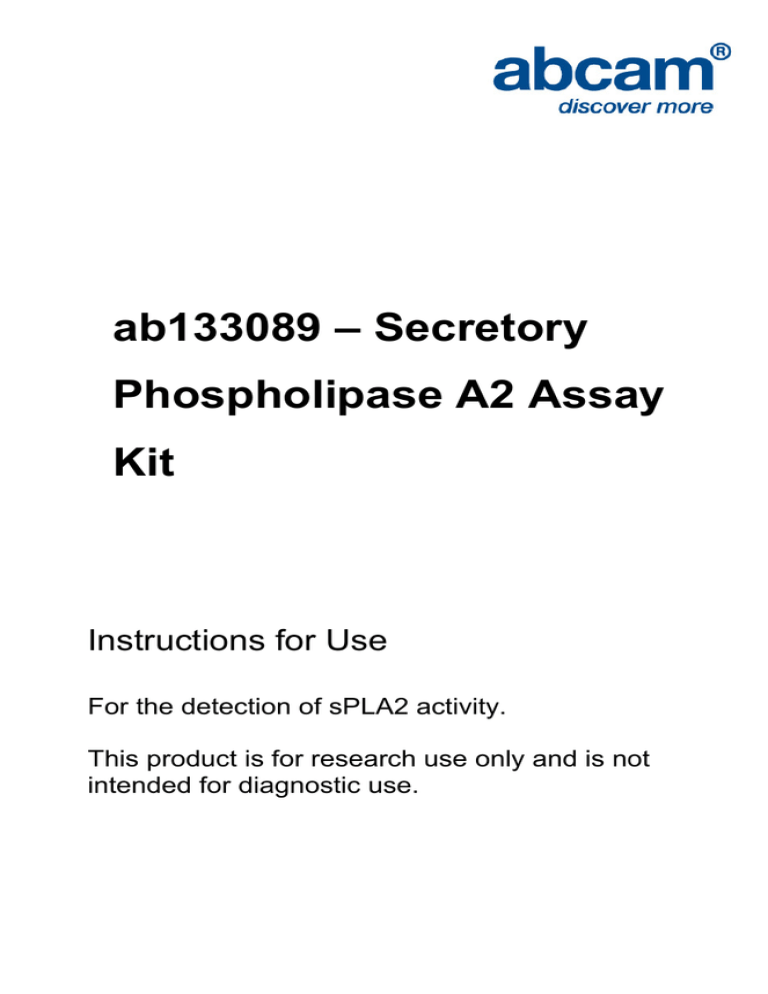
ab133089 – Secretory Phospholipase A2 Assay Kit Instructions for Use For the detection of sPLA2 activity. This product is for research use only and is not intended for diagnostic use. 1 Table of Contents 1. Overview 3 2. Background 5 3. Components and Storage 5 4. Pre-Assay Preparation 6 5. Assay Protocol 9 6. Data Analysis 13 7. Troubleshooting 17 2 1. Overview ab133089 provides an accurate and convenient method for measurement of sPLA2 activity. This assay uses the 1,2-dithio analog of diheptanoyl phosphatidylcholine which serves as a substrate for most PLA2s (e.g., bee and cobra venoms, pancreatic, etc.) with the exception of cytosolic PLA2. Upon hydrolysis of the thio ester bond at the sn-2 position by PLA2, free thiols are detected using DTNB (5,5’-dithio-bis-(2-nitrobenzoic acid)) (see Figure 1) . 3 Figure 1. Scheme 4 2. Background Phospholipase A2 (PLA2) catalyzes the hydrolysis of phospholipids at the sn-2 position yielding a free fatty acid and a lysophospholipid. The release of arachidonic acid from membrane phospholipids by PLA is believed to be a key step in the control of eicosanoid production within the cell. 3. Components and Storage This kit will perform as specified if stored at -20°C. Item Quantity sPLA2 Assay Buffer (10X) 1 vial sPLA2 DTNB 4 vials sPLA2 Diheptanoyl Thio-PC (Substrate) 2 vials Bee venom PLA2 Control 1 vial 96-Well Plate (Colorimetric Assay) 1 plate 96-well cover sheet 1 cover 5 Materials Needed But Not Supplied A plate reader capable of measuring absorbances at 405 or 414 nm. Adjustable pipettes and a repeat pipettor. A source of pure water; glass distilled water or HPLC-grade water is acceptable. 4. Pre-Assay Preparation Some of the kit components are in lyophilized form and need to be reconstituted prior to use. Follow the directions carefully to ensure proper volumes of water or Assay Buffer are used to reconstitute the vial components. A. Reagent Preparation sPLA2 Assay Buffer Dilute 3 ml of Assay Buffer concentrate with 27 ml of HPLCgrade water. This final Assay Buffer (25 mM Tris-HCl, pH 7.5, containing 10 mM CaCl2, 100 mM KCl, and 0.3 mM Triton X100) should be used for reconstitution of substrate and dilution of samples prior to assaying. 6 sPLA2 DTNB Reconstitute the contents of one vial with 1.0 ml of HPLC-grade water to yield 10 mM DTNB in 0.4 M Tris-HCl, pH 8.0. Store the reconstituted reagent on ice in the dark and use within eight hours. sPLA2 Diheptanoyl Thio-PC (Substrate) Reconstitute the contents of each vial with 12 ml of diluted Assay Buffer to achieve a final concentration of 1.66 mM. Make sure to vortex until the substrate solution becomes clear (high background absorbance may result if the substrate is not completely dissolved). The substrate, when stored at -20°C in diluted Assay Buffer, is stable for at least two weeks. NOTE: If not using the entire plate, then reconstitute only one of the substrate vials. Bee Venom PLA2 Control A 100 µg/ml solution of bee venom PLA2 is supplied as a positive control. To avoid repeated freezing and thawing, the PLA2 can be aliquoted into several small vials. Bee venom PLA2, when stored at -20°C, is stable for one year. Transfer 10 µl of the supplied enzyme to another vial and dilute with 990 µl of diluted Assay Buffer prior to use. Store the enzyme on ice and use within one hour. A 10 µl aliquot of this diluted enzyme per well causes an increase of approximately 0.1 absorbance unit/minute under the standard assay conditions described 7 below. The PLA2 can be further diluted with Assay Buffer if a slower reaction rate is desired. B. Sample Preparation In general, any sPLA2 sample can be measured by this assay. The sample must be free of particulates to avoid interferences in the absorbance measurement. Thiols, thiol ‘scavengers’, and PLA2 inhibitors must be removed from the samples before performing the assay (extensive dialysis will eliminate most of the interfering substances of small molecular size). If the samples are too dilute, they can be concentrated using an Amicon centrifuge concentrator with a molecular weight cut-off of 3,000 Da. 8 5. Assay Protocol A. Plate Setup There is no specific pattern for using the wells on the plate. However, it is necessary to have some wells (at least two) designated as non-enzymatic controls. The absorbance rate of these wells must then be subtracted from the absorbance rate measured in the sample wells. We suggest that you have at least two wells designated as positive controls. Blk – Blank Wells + = Positive Control Wells S1-S46 = Sample Wells 9 Pipetting Hints: It is recommended that an adjustable pipette be used to deliver Substrate, DTNB, and Buffer to the wells. This saves time and helps to maintain more precise times of incubation. Use different tips to pipette Substrate, DTNB, and sample. Before pipetting each reagent, equilibrate the pipette tip in that reagent (i.e., slowly fill the tip and gently expel the contents, repeat several times). Do not expose the pipette tip to the reagent(s) already in the well. General Information: The final volume of the assay is 225 µl in all wells. It is not necessary to use all the wells on the plate at one time. If the appropriate enzyme dilution is not known, it may be necessary to assay at several dilutions. Use the Assay Buffer (dilute) in the assay. 10 B. Performing the Assay Blank Wells (Non-enzymatic controls) Add 10 µl DTNB and 15 µl Assay Buffer to at least two wells (if performing inhibitor studies,* add 5 µl DMSO and 10 µl Assay Buffer instead of 15 µl Assay Buffer). Positive Control Wells (Bee Venom PLA2) Add 10 µl DTNB, 10 µl Bee Venom PLA2, and 5 µl Assay Buffer to at least two wells (if performing inhibitor studies,* add 5 µl DMSO instead of 5 µl Assay Buffer). Sample Wells Add 10 µl DTNB, 10 µl sample, and 5 µl Assay Buffer to at least three wells (if performing inhibitor studies,* add 5 µl of inhibitor dissolved in DMSO instead of 5 µl Assay Buffer). To obtain reproducible results, the amount of PLA2 added to the well should cause an absorbance increase between 0.01 and 0.1/min. When necessary, samples should be concentrated or diluted with Assay Buffer to bring the enzymatic activity to this level. NOTE: The amount of sample added to the well should always be 10 µl. Initiate the reactions by adding 200 µl Substrate Solution to all the wells. Make sure to note the precise time you started and add the Substrate Solution as quickly as possible. 11 Carefully shake the plate to mix. Read the absorbance every minute at 414 (or 405) nm using a plate reader to obtain at least five time points. *Inhibitors should be dissolved in DMSO and should be added to the assay in a final volume of 5 µl. In the event that the appropriate concentration of inhibitor is completely unknown, we recommend that several different dilutions of the inhibitor in DMSO be made. 12 6. Data Analysis A. Calculations 1. Determine change in absorbance (ΔA414) per minute by: a) Plotting the absorbance values as a function of time to obtain the slope (rate) of the linear portion of the curve (an example is shown using bee venom, snake venom, human synovial, and bovine pancreas PLA2s) OR b) Select two points on the linear portion of the curve and determine the change in absorbance during that time using the following equation: ∆A414 = A414 (Time 2) - A414(Time 1) Time 2 (min.) - Time 1 (min.) 2. Determine the rate of ΔA414/min for the non-enzymatic controls (Blanks) and subtract this rate from that of the sample wells. 3. Use the following formula to calculate the sPLA2 activity. The reaction rate at 414 nm can be determined using the DTNB extinction coefficient of 10.66 mM-1. **One unit of enzyme hydrolyzes one µmol of diheptanoyl Thio-PC per minute at 25°C. 13 sPLA2 Activity (µmol/min/ml) = ∆A414/min x 0.225 ml x Sample dilution 10.66 mM-1 0.01 ml **The actual extinction coefficient for DTNB at 414 nm is 13.6 mM1cm-1. This value has been adjusted for the path length of the solution in the well (0.784 cm). The extinction coefficient for DTNB at 405 nm is 12.8 mM-1cm-1. The adjusted value is 10.0 mM-1. B. Performance Characteristics Sensitivity: The detection range of this assay is from 0.02 to 0.2 µmol/min/ml of sPLA2 activity which is equivalent to an absorbance increase of 0.01 to 0.1 per minute. Precision: When a series of 16 bee venom PLA2 measurements were performed on the same day, the intra-assay coefficient of variation was 2.5%. When a series of 16 bee venom PLA2 measurements were performed on five different days under the same experimental conditions, the inter-assay coefficient of variation was 4.2%. 14 Figure 2. Absorbance times for bee venom, snake venom, human synovial, and bovine pancreas PLA2s. C. Interferences 1. Solvents A dramatic decrease in enzymatic activity was observed when ethanol is added to the assay. Methanol also affects enzymatic activity but to a lesser extent. The addition of DMSO has little effect on enzymatic activity. 15 2. Culture Media and Buffers All buffers and media should be tested for background absorbance before doing any experiments. If the initial background absorbance is higher than 0.3 absorbance units then the samples should be diluted in Assay Buffer or water before performing the assay. Tris, HEPES, and phosphate buffers (25 mM) work in the assay but imidazole buffers have high background absorbances. The following media also work in the assay: Grace’s, RPMI 1640, DMEM, HAM’s F12, and IMDM. 3. Thiols and Thiol-Scavengers Samples containing thiols (e.g., glutathione, cysteine, dithiothreitol, or 2-mercaptoethanol) will exhibit high background absorbances and interfere with PLA2 activity determination. Samples containing thiol-scavengers (e.g., Nethylmaleimide) will inhibit color development. Extensive dialysis will eliminate most of the interfering substances of small molecular size. 7. Troubleshooting 16 Problem Possible Causes Recommended Solutions Erratic values; dispersion of duplicates/ triplicates A. Poor pipetting/technique A. Be careful not to splash the contents of the wells. No color development A. DTNB or sample was not added to well(s). A. Make sure to add all components to the wells B. The enzymatic activity was too low B. Standardize the assay with Bee Venom PLA2 The color development was too fast Too much enzyme added to well(s) Dilute your samples with diluted Assay Buffer and reassay High background absorbance A. Substrate not in solution A. Make sure to vortex the substrate until a clear solution is made B. Bubble in the well(s) B. Carefully tap the side of the plate with your finger to remove bubbles. B. Thiols present in sample The reaction rate is not linear at high absorbance Plate reader not sensitive enough at high absorbance B. Remove thiols or thiol reagents from sample A. Use only the points at lower concentrations in the linear portion for making the curve B. Dilute your sample with diluted Assay Buffer 17 and re-assay 18 UK, EU and ROW Email:technical@abcam.com Tel: +44 (0)1223 696000 www.abcam.com US, Canada and Latin America Email: us.technical@abcam.com Tel: 888-77-ABCAM (22226) www.abcam.com China and Asia Pacific Email: hk.technical@abcam.com Tel: 108008523689 (中國聯通) www.abcam.cn Japan Email: technical@abcam.co.jp Tel: +81-(0)3-6231-0940 www.abcam.co.jp Copyright © 2012 Abcam, All Rights Reserved. The Abcam logo is a registered trademark. All information / detail is correct at time of going to print. 19

